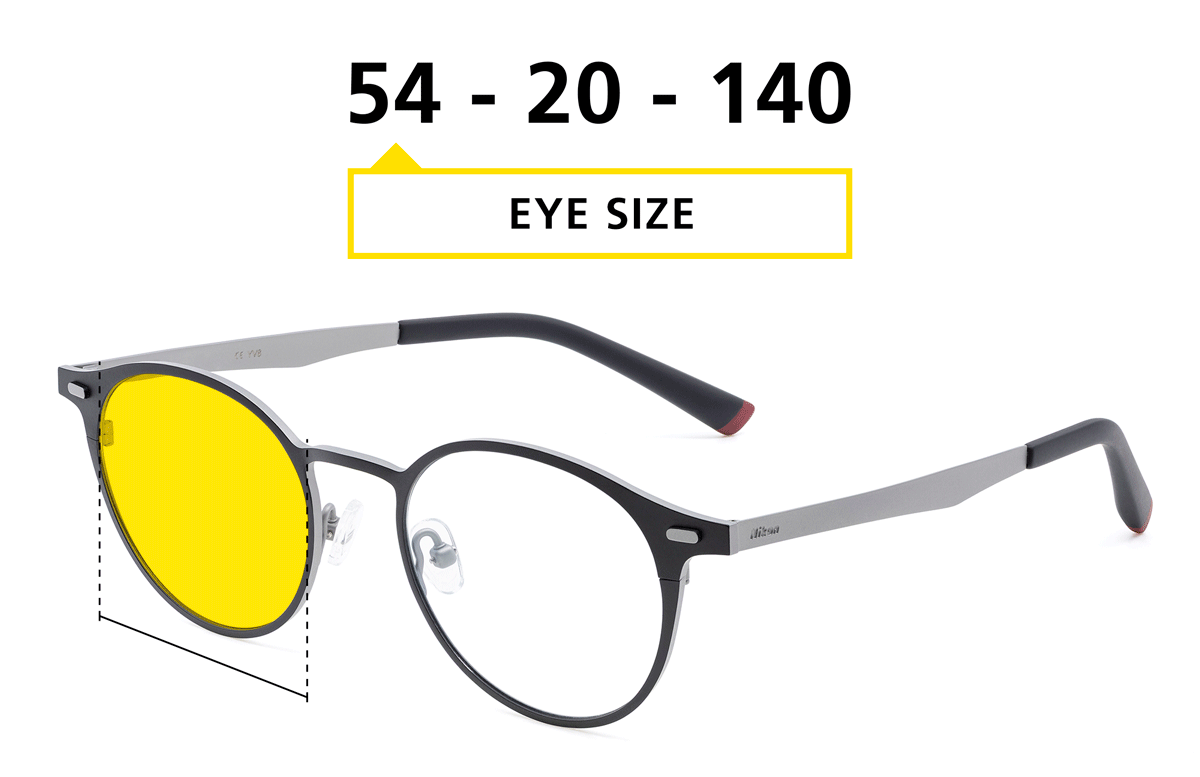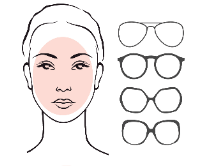About size and frame selection
I – About size selection
There are many different eyeglass sizes and your frame should be fitted by a skilled optician to ensure the best fit, comfort, and appearance.
How to find your size on your current frames?
Every pair of glasses is a little different, so the size information may not always be located in the same place. Look on the inside of your current frames. You will find the size information stamped either on the temple.

- Eye Size: a two-digit number in the 40 – 62 range. It is the horizontal width of each lens in millimeters.
- Bridge width: a two-digit number in the 14 – 24 range. It is the distance between the two lenses in millimeters.
- Temple length: a three-digit number in the 120 – 150 range. It is the length from screw to temple tips.
Every time you choose new glasses, the sizes will be a little different. In fact, each eyeglass frame is unique and several can fit you.
Opticians are trained to help you choose the right size glasses for your eyes and face. But sometimes even the right size of glasses requires an extra adjustment. For example, if your glasses slip on your nose, or hurt behind your ears, your optician can adjust the glasses to improve the fit and comfort.
II – About frame selection
Did you know that the shape of you face can help you choose your new pair of glasses ?

Do you have a round face?
What does that mean? Your facial features are rounded. They are uniform in both length and width.
Which frame to choose? Choose frames that are more rectangular in shape and stretched to help you refine your face.

Do you have an oval-shaped face?
What does this mean? Here, too, your face has a rounded shape. But unlike the round face, your face is longer than it is wide.
Which frame to choose? You have the chance to have a morphology that allows you all styles. All frame shapes can fit an oval face. You just need to choose a frame that fits your size and meets all your requirements, both in terms of style and optical quality.

Do you have a triangular face?
What does it mean? Your face is narrower at the chin than at the forehead. It is also often referred to as a heart-shaped face.
Which frame should I choose? You can choose a frame with a rather rounded shape, rather wide, especially at the lower edge. Rimless frames are also particularly suitable.

Do you have a square face?
What does this mean? The lines of your forehead and jaw line up. Your forehead is rather broad and you have a fairly pronounced jaw.
Which frame to choose? To soften the angles of your face, choose round, oval or “butterfly” shapes. Avoid square or overly geometric shapes that will accentuate the width of your face.

Do you have a rectangular face?
What does this mean? Your forehead is rather wide and you have a rather pronounced jaw. The lines of your forehead and jawline are rather aligned in terms of width, but your face is elongated.
Which frame to choose? The oval and “butterfly” shapes are particularly suitable, as they help to balance the length and width of the face. Avoid shapes that are too round and geometric, which will make your face look longer.
Whatever shape of glasses you choose, for maximum long term comfort, please also pay attention to the following points:
- The top of the frame must be well aligned with your eyebrow line. Indeed, your eyebrows should not be seen through your lenses, or on the contrary, they should be hidden by the top of your frame. This would risk unbalancing the harmony of your face.
- Your eyelashes must not touch the lenses: this is not comfortable and will dirty the lenses. If this happens to you, ask your optician to adjust your frame.
- The bottom of your glasses should not touch your cheekbones, even when you smile.
- The width of your glasses should be adjusted to suit you. There are different frame widths to fit all types of faces. When you try on a frame, make sure that the temples do not extend too far apart towards your ears. If this is the case, it means that the frame is too small for your face, and your eyesight may even be impaired. Ask your optician for another size.
Should your vision correction be taken into account when choosing your pair of glasses?

Remember that it is important to take your correction into account when finalising your choice of frame. Indeed, if your correction is important, the lens will be thick (in the centre or on the edges depending on your ametropia). It is then possible that certain shapes or models are not adapted to your visual needs. To make sure you don’t make a mistake, ask your optician for advice: he has the expertise to advise you on the models that will suit you best. He can also recommend thinner lenses, which will give you a wider range of choices.
